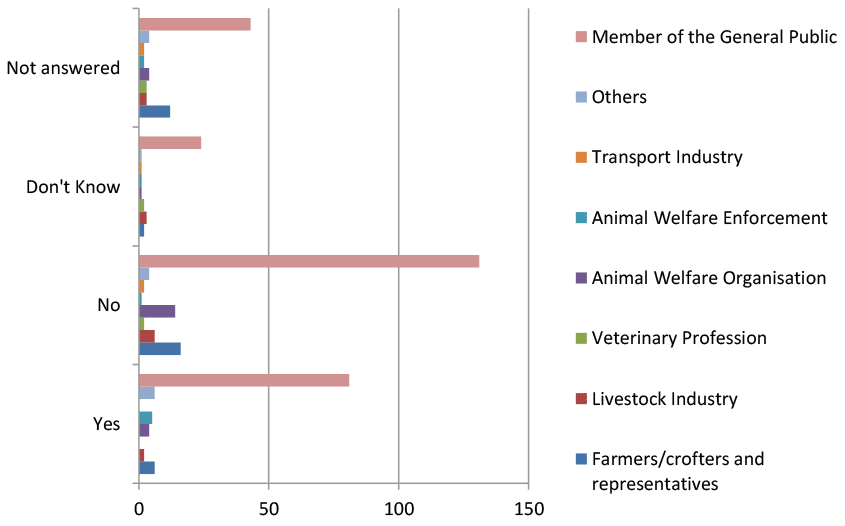Welfare of animals during transport - consultation: summary report
Analysis of the responses received to the full public consultation, between 4 December 2020 to 26 February 2021, of the Farm Animal Welfare Committee's opinion on the welfare of animals during transport.
Question 10
Do you agree with the Scottish Government’s position on maximum journey length and proposed course of action? Please provide any further relevant information.
It is the view of the Scottish Government that setting clear maximum journey times for each species is a core protection in our welfare in transport regulatory system. We note that FAWC has proposed the same maximum journey times for some species irrespective of the purpose or type of journey. We agree that:
- maximum journey times should reflect the latest scientific evidence and should take relevant factors into account, such as if the animal is unweaned, young, juvenile, adult, or end of life.
- the particular desirable maximum journey times proposed by FAWC, in their Table 7, should be considered for adoption, subject to full consideration of the evidence in the systematic review and other evidence that becomes available.
- in relation to FAWC’s specific maximum journey time recommendations, the shortest journey time should be applied in all circumstances, in particular that specific additional written permission from the relevant devolved UK authority should be obtained for any journey exceeding 21 hours following an application explaining why such a journey is justified.
- the nine hour maximum journey time for all unweaned or recently weaned animals (except newly weaned pigs, where eight hours is recommended), subject to considering other scientific evidence and particular geographical constraints within the UK.
In taking the recommendations forward we would wish to consider how maximum permitted times apply to journeys from remote areas and we would wish to consider the justifications which could apply to such journeys, including in terms of the potential welfare benefits of the journeys for those animals affected.

Of the 315 responses to this question, 33.0% were in favour of the Scottish Government’s position on maximum journey length and proposed course of action. 55.9% were not in favour and 11.1% did not express a view.
A number of respondents linked the journey times to the “number, and distribution of slaughter facilities across Scotland” and commenting that if Government wished to reduce transport times “there must be significant support, investment and growth in slaughter facilities and further processing across Scotland”. (NFU Scotland).
While some respondents agreed, in principle, the setting of species-specific, maximum journey times based on scientific evidence a number suggested that they were less supportive of FAWC’s proposed limits and sought further clarification on how these had been determined.
Others in support of the proposal suggested that clarification would be required on the future definitions of travelling and rest time; with suggestions that sea journeys in “proven cassette transport units must remain classed as neutral” (Stromness Community Council). A small number of comments received to this question also considered that “time … at markets should not be counted” (individual).
A number of respondents, and their representatives, from the remote rural sector and enforcement and livestock sectors welcomed the Scottish Government’s commitment to consider how maximum permitted times apply to journeys from remote areas. A high number of organisation and individual responses from remote rural areas also suggested that “The proposed 21/24 journey times for older cattle and sheep could be accepted if the current “neutral time” arrangement … continues to be maintained” (individual).
Comments were also received on the transport of weaned and recently unweaned animals with an individual respondent suggesting a statutory definition of weaning age for animal species “would have to be included in any legislation”. Other comments mentioned the farming practices in the Northern isles where calves born in the spring are usually weaned before they are 9 months old and transported to richer pastures on the mainland as an “essential component of their welfare” (Shetland Islands Council). .
Another respondent gave information on transport practices in the Western Isles where “many of the floats will carry mixed ages of cattle to make the transport as economic as possible … This means that either all stock is limited to 9 hours or that the lorry has to unload somewhere” (individual).
With regard to journeys greater than 21 hours, the British Veterinary Association suggested that the Animal Plant & Health Agency should “be required to produce a report that would be shared with Scottish Ministers to ensure ministerial oversight and accountability”.
A number of animal welfare organisations agreed the setting of maximum journey times and, in general terms, suggested that “the proposed new maximums are still too long” (unnamed organisations); and “no journey for slaughter or fattening should exceed 8 hours for mammals … or exceed 4 hours for poultry” (Compassion in World Farming).
Contact
There is a problem
Thanks for your feedback